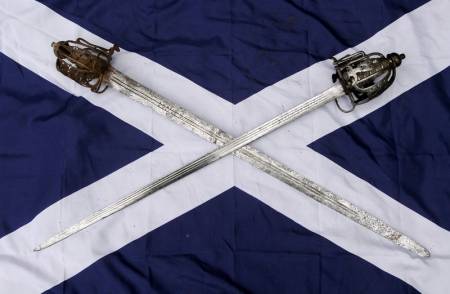I received an email through our Clan Gunn Commissioners' Group tonight that I thought was very interesting and wanted to share it. The text of the post from the sword forum by Paul Macdonald tells it all. I do not know anything about Mr. Macdonald but am sure a lot of you do. So here it is.
Here is the posting from Paul Macdonald.
http://forums.swordforum.com/showthread.php?t=80548
Dear All,
It is a pleasure to recount recent adventures by the sword again, this time in bringing together some rare Scottish legends.
I was recently contacted by an elderly Scots lady and asked if I could restore an old sword that had "been in the family for some time".
This turned out to be the sword of Charles Stuart of Ardshiel, a renowned Jacobite, who survived the battles of Sherrifmuir and Culloden, commanding the Stuarts of Appin there.
He also was regarded as one of the greatest swordsmen in Scotland in his day and during his Life of adventure had an encounter with another legendary Scot, one Robert Roy MacGregor.
The sword I received to work on was that which he had used to face MacGregor and as a result became the only swordsman to successfully defeat Rob Roy by the sword.
What is more, MacGregor eventually succumbed to infection of this wound and died as a result. This was the sword that had shed the blood of and ultimately killed Rob Roy.
This particular piece has been kept in Ardshiels direct family to this day and carries full historical provanance.
On the back of this, I decided to chase a local legend back home in Moidart, West Highlands, concerning the whereabouts of Rob Roys own sword.
This I discovered and also received to restore.
This has been the first time the two swords have been together for nearly three hundred years.
As a result of much research, the full and original story of the duel itself has become known (as Sir Walter Scott has led historians to believe a different version over the years) and the two swords re-united for a brief period again, and this time, they met in peace.
Both are typical pattern Scottish basket hilts of the period (MacGregors being a bit earlier c.1680 - 90), but with quite different blades, weight and feel overall.
So, here they both are (MacGregors on the left, Ardshiels right) -
Legends still, and an honor to have known. May their spirit yet inspire us All.
Yours Very Truly,
Macdonald
www.historicalfencing.org/Macdonaldarmory
